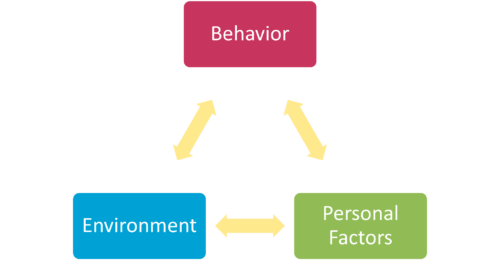Social Cognitive Theory
Presented by Joe Tise, PhD, Educational Psychology & Senior Education Researcher at CSEdResearch.org
In light of these two influential (albeit largely opposing) theories of learning, we see that both theories account for unique aspects of learning despite their limitations. Still, neither behaviorist nor information-processing theories account for one prominent form of learning, with which all people have experience—learning by observation. We may rightfully wonder then: is there a new theory that incorporates the strongest elements of each and can explain how humans learn through observing others? Enter: Social-cognitive theory (SCT; Bandura, 1986).
SCT is largely attributed to the prominent psychologist Albert Bandura, but many other theorists have since produced high quality research that has supported and refined the theory, especially within educational contexts (e.g., Barry Zimmerman, Paul Pintrich, Dale Schunk).
SCT posits human behavior is one part of a triadic, reciprocal relationship with the environment (think behaviorism) and personal factors (IPT is represented here). The figure below represents this relationship visually.

Whereas behaviorist theories of learning drew only a one-way connection between environment and behavior (i.e., environment determines behavior) and IPT essentially stayed within the cognitive system entirely, SCT asserts that the environment, behavior, and personal factors (e.g., ways of thinking, attitudes, emotions, metacognition) all influence and partially determine each other.
Support for this assertion comes from decades of research kicked off by the seminal bobo doll experiments at Stanford (Bandura et al., 1961, 1963). These groundbreaking experiments were some of the first to show empirically that humans do learn through observation.
This evidence directly contradicted a basic tenet of behaviorism—that organisms only learn after the environment acts upon them directly (e.g., through direct punishment or reward). These experiments further showed that one’s behavior (children in this case) is influenced not just by the environment (in these experiments, the presence of an aggressive-acting adult), but also by personal factors (in these experiments, the children’s gender). Thus, learning in SCT is inherently tied to the context and learners’ personal factors.
From these basic tenets, we get the SCT definition of learning: a change or potential for change in behavior or cognition, situated within specific contexts.
Strengths
- Social-cognitive theory is deceptively simple—it involves just three overarching components but each component represents countless influential factors.
- SCT incorporates many of the strengths of both behaviorism and IPT and extends both theories in unique ways. It is the only theory of learning that sufficiently explains observational learning. It is also highly relevant to both research and practice.
- SCT explains many complex human phenomena, such as self-efficacy, self-regulated learning, stereotype threats, and the influence of role models. Others have adapted SCT to other realms, for example business where it is referred to as social-cognitive career theory (SCCT; Lent et al., 1994, 2002).
Limitations
- SCT can be a bit more abstract than behaviorism or IPT and thus the implications for practice are sometimes less clear. This is especially true for researchers and practitioners who are unfamiliar with learning theories.
- Further, because of its deceptive complexity, a comprehensive test of SCT within a single study is more difficult compared to behaviorism and IPT. Controlling for the numerous environmental, personal, and behavioral factors that SCT might identify as relevant would be a heavy lift for even the most well-funded research study to accommodate.
Potential Use Cases in Computing Education
- Research: A study could investigate how characteristics of a role model (e.g., race/ethnicity, gender, age) moderate the influence that role model has on underrepresented children’s intentions to pursue a particular STEM career path.
- Practice: Teachers, mentors, and parents should highlight examples of when a student successfully overcame a challenge, and provide verbal encouragement and/or modeling when the student faces new challenges. These behaviors will support the student’s self-efficacy, and ultimately their persistence in the domain/on the task
Influential theorists:
- Albert Bandura (1925 – 2021)
- Barry J. Zimmerman (1942 – present)
- Paul R. Pintrich (1953 – 2003)
Recommended seminal works:
Bandura, A., Ross, D., & Ross, S. A. (1961). Transmission of aggression through imitation of aggressive models. Journal of Abnormal and Social Psychology, 63(3), 575–582.
Bandura, A. (1977). Self-efficacy: Toward a unifying theory of behavioral change. Psychological Review, 84(2), 191–215. https://doi.org/10.1111/1467-9280.00090
Bandura, A. (1986). Social foundations of thought & action: A social cognitive theory. Pearson Education.
Bandura, A. (1989). Human agency in social cognitive theory. American Psychologist, 44(9), 1175–1184. https://doi.org/10.1037/0003-066X.44.9.1175
References
Bandura, A., Ross, D., & Ross, S. A. (1961). Transmission of aggression through imitation of aggressive models. Journal of Abnormal and Social Psychology, 63(3), 575–582.
Bandura, A., Ross, D., & Ross, S. A. (1963). Imitation of film-mediated aggressive models. The Journal of Abnormal and Social Psychology, 66(1), 3–11. https://doi.org/10.1037/h0048687
Bandura, A. (1986). Social foundations of thought & action: A social cognitive theory. Pearson Education.
Lent, R. W., Brown, S. D., & Hackett, G. (1994). Toward a Unifying Social Cognitive Theory of Career and Academic Interest, Choice, and Performance. Journal of Vocational Behavior, 45(1), 79–122. https://doi.org/10.1006/jvbe.1994.1027
Lent, R. W., Brown, S. D., & Hackett, G. (2002). Social Cognitive Career Theory. In D. Brown (Ed.), Career Choice and Development (4th ed., pp. 255–311). Jossey-Bass.
Series

Comments are closed